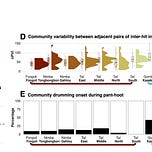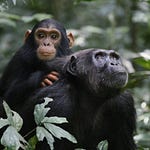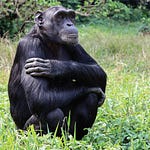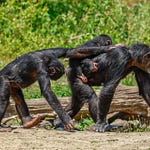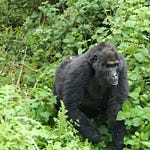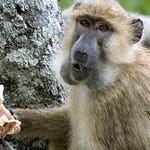The Forest Has a Pulse
In the dense, tangled canopies of the Ugandan rainforest, the low boom of a chimpanzee drumming on a tree root reverberates through the undergrowth. To the untrained ear, it may sound like chaos. But for a growing number of researchers, these percussive outbursts are revealing the rhythmic seeds of a very human phenomenon: music based upon a 2022 study1 and a brand new 2025 study2.
Chimpanzees, long known for their complex vocalizations and tool use, now appear to drum in a way that is not only individually distinctive—but rhythmically patterned and socially meaningful. And just as regional dialects differentiate human speech communities, recent findings suggest chimpanzees across Africa also drum with subspecies-specific styles.
“Showing that chimpanzees share some of the fundamental properties of human musical rhythm in their drumming is a really exciting step in understanding when and how we evolved this skill,” said primatologist Catherine Hobaiter.
Signature Styles in the Rainforest
The initial hint came from the Waibira chimpanzee group in Uganda’s Budongo Forest, where researchers recorded drumming bouts by male chimpanzees beating their feet and hands against the buttress roots of towering trees. These performances echoed across the forest, serving as auditory beacons that identified individuals and conveyed social context.
“Tristan—the John Bonham of the forest—makes very fast drums with many evenly separated beats,” said lead author Vesta Eleuteri, describing one particularly prolific chimpanzee. “His drumming is so fast that you can barely see his hands.”
Each chimp, it turns out, has a kind of rhythmic fingerprint. Some favor even, rapid-fire beats. Others lean into syncopation, with irregular but patterned strikes that resemble improvisational jazz. The chimps use these rhythms not only to signal their presence but—on occasion—to conceal it.
“They have this wonderful flexibility to express their identity and their style, but also to sometimes keep that hidden,” said Hobaiter.
Across Africa, Different Grooves
In a follow-up study published in Current Biology, Eleuteri and colleagues expanded their scope. Analyzing 371 drumming bouts across 11 chimpanzee communities, they found that not only do individuals have their own percussive voices—so do entire subspecies.
Western chimpanzees (Pan troglodytes verus) tended to favor evenly spaced, rapid beats, often initiating their drumming at the beginning of their signature pant-hoot vocalizations. Eastern chimpanzees (Pan troglodytes schweinfurthii), by contrast, more frequently varied their tempo, alternating short and long intervals in more complex patterns.
“We didn’t expect to see such clear differences in rhythm,” Eleuteri noted. “Or to find that their drumming rhythms shared such clear similarities with human music.”
The implications ripple outward. The fact that chimpanzees drum with rhythm—and that this behavior differs systematically between subspecies—suggests that at least some musical faculties evolved long before Homo sapiens appeared on the scene. These behaviors may have emerged in a common ancestor shared by humans and chimpanzees more than six million years ago.
A Beat You Can Travel To
Unlike other forms of vocalization, which may be limited by the density of the forest, drumming on trees allows the sound to carry over long distances. In this way, a lone chimpanzee on the move can announce their travel or coordinate with distant group members.
But unlike territorial howling or threat calls in other species, chimpanzee drumming carries personality and context. Some beats are for bonding, others for bragging. And in certain cases, chimps appear to withhold their distinct rhythms, possibly to avoid detection.
Rhythm, in this case, is not simply communicative—it is strategic. It may also be, in a nontrivial sense, expressive.
“I do think that chimpanzees, like us, potentially have a sense of rhythmicity, a sense of music,” said Hobaiter. “Something that touches them on an almost emotional level.”
Not Just Tools and Meat
Much of what is known about chimpanzee culture has centered on tool use, hunting practices, and dietary preferences. But as Hobaiter points out, human culture is as much about what we create—music, art, ritual—as how we subsist.
“Most studies of animal culture focus on what animals eat or how they make tools,” she said. “But if we think about human culture, we don’t define ourselves by the tools we use—we define ourselves by the music we listen to, how we dance, what we value.”
The cultural variability in chimpanzee drumming offers a new window into this broader, more symbolic world. And it encourages a reconsideration of the evolutionary path that gave rise to human music.
Beats Before Language?
While language is often heralded as the defining feature of human cognition, rhythm may have come first. Rhythmic entrainment—the ability to keep a beat—is rare among non-human animals but universal among human cultures. The drumming chimpanzees suggest that this trait may have deep evolutionary roots.
The flexibility, individuality, and inter-group differences in chimpanzee drumming hint at a proto-musicality: a way of structuring sound for expression, identity, and connection.
Just as early humans used drums, rattles, and flutes to accompany rituals or travel songs, it now appears that other apes may have done something similar, using the natural resonators of the forest to make themselves heard—and known.
Related Research
Merker, B., Madison, G., & Eckerdal, P. (2009). On the role and origin of isochrony in human rhythmic entrainment. Cortex, 45(1), 4–17. https://doi.org/10.1016/j.cortex.2008.06.011
Patel, A. D. (2006). Musical rhythm, linguistic rhythm, and human evolution. Music Perception, 24(1), 99–104. https://doi.org/10.1525/mp.2006.24.1.99
Schögler, B., & Trevarthen, C. (2007). To sing and dance together: From infants to jazz. Musicae Scientiae, 11(1_suppl), 169–191. https://doi.org/10.1177/10298649070110S110
Fitch, W. T. (2015). Four principles of bio-musicology. Philosophical Transactions of the Royal Society B, 370(1664), 20140091. https://doi.org/10.1098/rstb.2014.0091
Eleuteri, V., Henderson, M., Soldati, A., Badihi, G., Zuberbühler, K., & Hobaiter, C. (2022). The form and function of chimpanzee buttress drumming. Animal Behaviour, 192, 189–205. https://doi.org/10.1016/j.anbehav.2022.07.013
Eleuteri, V., Hobaiter, C., Ravignani, A., Zuberbühler, K., & Gruber, T. (2025). Chimpanzee drumming shows rhythmicity and subspecies variation. Current Biology. Advance online publication. https://doi.org/10.1016/j.cub.2025.04.048

